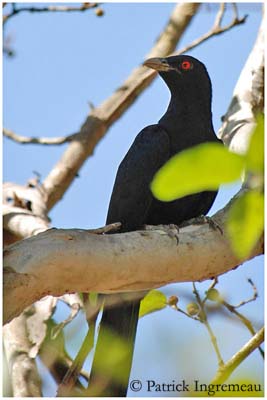
Asian Koel
Eudynamys scolopacea
Cuculiforme Order – Cuculidae Family
BIOMETRICS:
Length: 39-46 cm
DESCRIPTION:
Asian Koel is a large cuckoo.
Adult male has glossy bluish-black or greenish-black plumage. Wings are relatively short, but tail is rather long.
Thick, large bill is slightly down-curved and very pale in colour. Eyes are bright red. Legs and feet are pale grey.
DIET :
Asian Koel feeds mainly on fruits and berries in trees, feasting on the ripe fruits. It also consumes insects and caterpillars. Adults often frequent orchards.
PROTECTION / THREATS / STATUS :
Asian Koel seems to be more common in towns, due to good food resources from plants producing fruits and berries.
Fr: Coucou Koël
All : Koel
Esp : Koel Común
Ital : Koel comune
Nd : Indische Koül
Sd : Koelgök
Photographs by Steve Garvie
His website: RAINBIRDER Photo galleries
Photographs of female by Didier Buysse
His website :
Vision d’Oiseaux
Photograph of male by Patrick Ingremeau
His website :
TAMANDUA
Text by Nicole Bouglouan
Sources:
LES OISEAUX DE THAILANDE par Roland Eve et Anne-Marie Guigue - Times Editions - ISBN: 9812042008
L’ENCYCLOPEDIE MONDIALE DES OISEAUX - Dr Christopher M. Perrins - BORDAS - ISBN: 2040185607
Wikipedia (Wikipedia, The Free Encyclopedia)

Female has smooth brown upperparts, heavily speckled with creamy white. Underparts are cream to whitish, finely barred with dark brown bars. Tail is barred dark grey and white. Crown is darker brown. Bill is pale greenish. Eyes are red.
Juvenile resembles female but it has dark eyes.
We can find up to 14 subspecies.
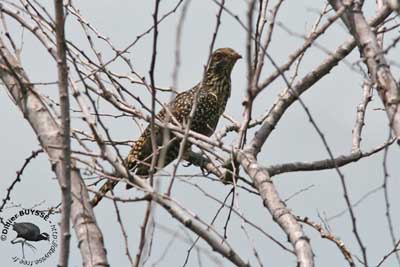
BEHAVIOUR:
Asian Koel is a shy bird, more heard than seen. When it is quiet, not alarmed, it adopts a typical stance with long tail held downwards, hunched back, head and bill uptilted. But often hidden in dense vegetation, it is difficult to see it. It is an arboreal species.
Asian Koel, as other cuckoos, lays its eggs, usually one single egg, in the nest of other birds’ species. They often choose crows’ nest. When male finds a good crow’s nest, it utters its very loud call “ko-eeul”, in order to attract a female Koel, to come lay her egg into this nest. Young Koel may, or not, eject host’s chicks or eggs. It is raised by other parents, often crows, and initially, young Koel calls as a crow!
During courtship display period, Asian Koel is very vocal and agitated. If excited male sees a female, both initiate spectacular chases along large branches and among trees. Breeding season depends of the place where pair is living.
Asian Koel can be seen alone or in pair. It feeds mainly in the canopy of trees. It takes fruits (mainly figs) directly from the tree.
FLIGHT:
Asian Koel performs direct flight as other cuckoos. They have straight and swift flight with rapid wing beats.
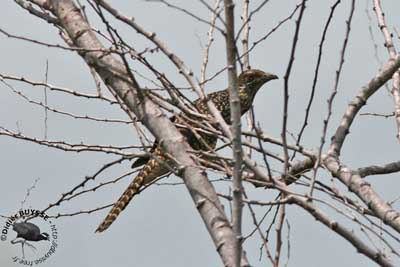
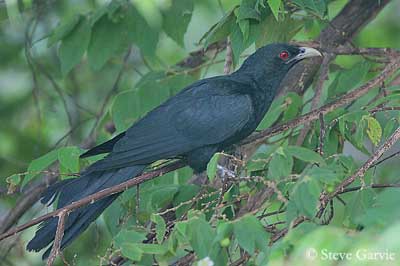
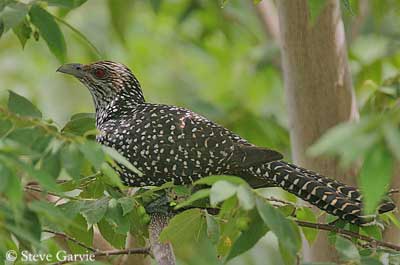
HABITAT:
Asian Koel lives mainly in dense thickets of trees or bamboos, scattered in the country. It is also found in coastal mangroves’ edges, shrubby areas with tall trees, gardens and woods, towns and villages.
RANGE:
Asian Koel lives in Australia, India, from south-eastern Asia to New Guinea, and Salomon Islands.
Birds living at the fringes of the range (eastern Australia), migrate to warmer areas in winter. Most of populations are resident in their range, but others perform some dispersion.
REPRODUCTION:
Asian Koel doesn’t build any nest. As other cuckoos, it is a brood parasite, and female lays her single egg in the nest chosen by the male. They often are crows’ nest.
Asian Koel’s egg is similar in colour to the crow’s eggs. It is pale greyish-green or stony coloured, speckled with reddish-brown; it is smaller than host’s eggs.
If chicks of the two species remain in the nest, Koel chick grows up faster, to the detriment of the host’s chicks. It may occur that young Koel pushes the other eggs or chicks out from the nest.
When young Koel leaves the nest, it roosts in the outer branches of trees, begging food to its foster parents which have to search for sufficient food to satisfy this hungry young.
Young Koel follows other Koels when they depart at the end of summer.